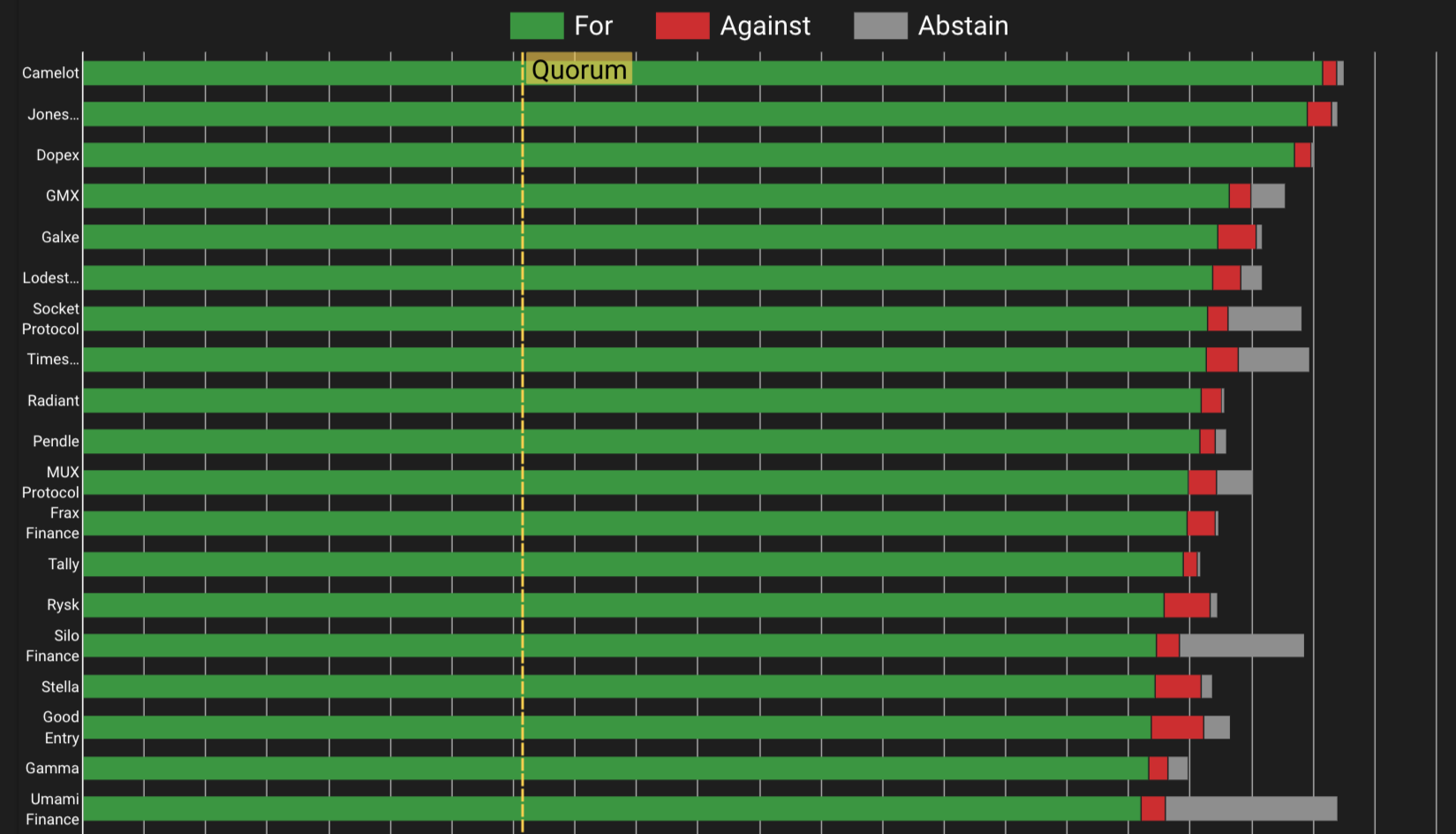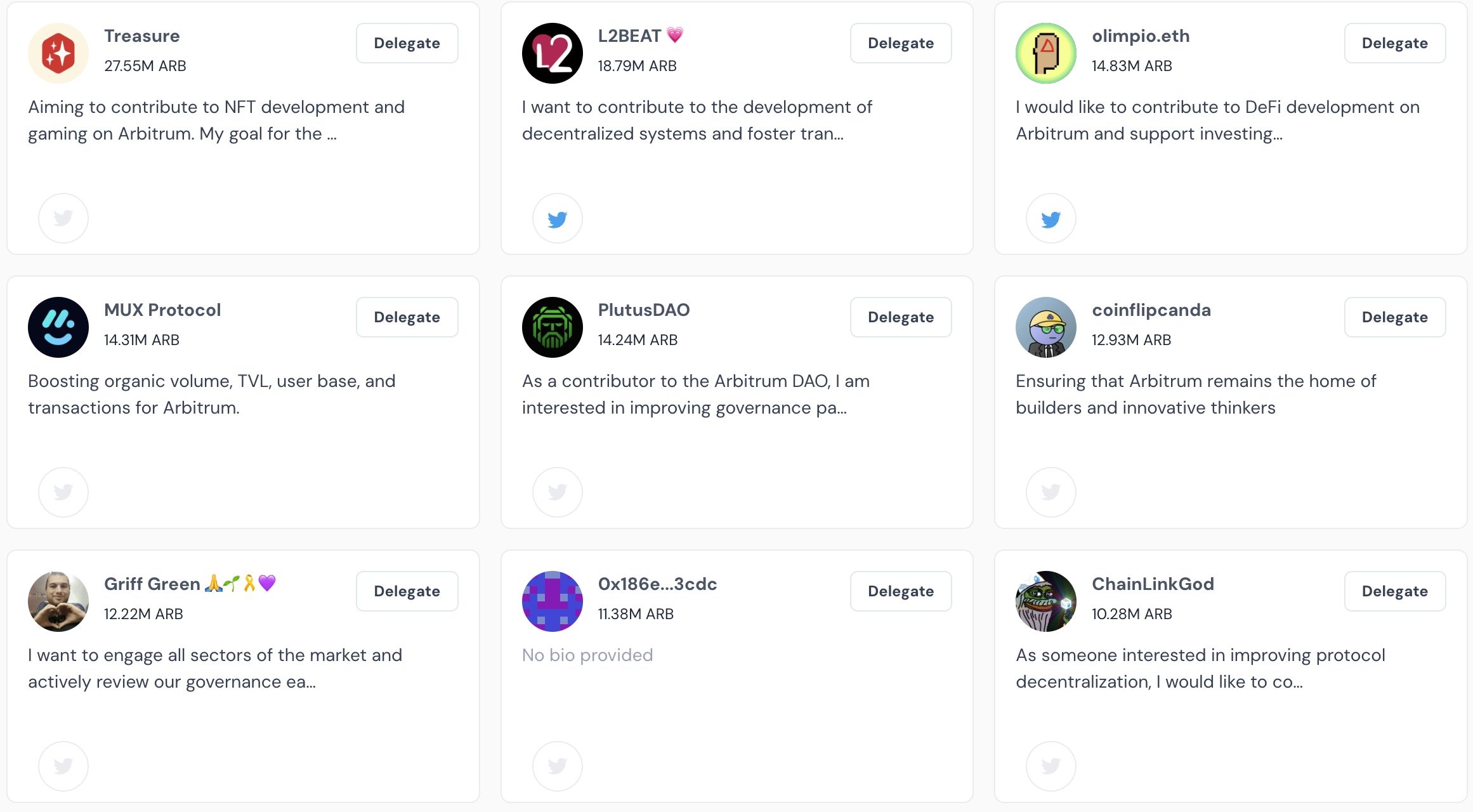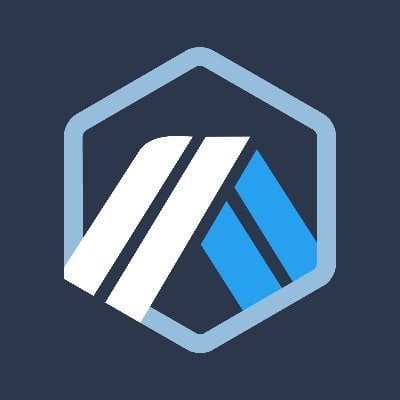The grant war of Arbitrum comes to an end: 57 projects share 50 million ARB, potentially becoming a classic case of DAO governance?
Written by: Jiang Haibo, PANews
The competition for tens of millions of dollars in grants within the Arbitrum community has come to an end. On October 13 at 10 AM, the Snapshot voting for the Arbitrum Short-Term Incentive Program concluded, with 57 out of 97 proposals passing. Native projects on Arbitrum received the most support, while the proposals that did not pass were mainly projects with low relevance to the Arbitrum ecosystem, including some controversial projects like Lido. However, the approved proposals requested a total of 74.05 million ARB, exceeding the 50 million limit, and will need to be filtered based on the number of supportive votes, meaning the final number of projects receiving grants may be less than 57.
According to voting data compiled by raho.me (detailed voting results can be viewed), all grant application proposals met the voting quantity requirements, but whether they receive approval is reflected in their support rates. The results show that most proposals were approved, and projects like Wormhole and Gains Network, which previously lacked sufficient votes, also received approval.
Most Supported Projects: Camelot, JonesDAO, Dopex, GMX
Data shows that the projects with the most supportive votes are Camelot, JonesDAO, Dopex, and GMX, all of which are native projects on Arbitrum. Camelot is the largest native DEX on Arbitrum, and Arbitrum is one of the most representative derivatives projects, so their high vote counts are not surprising. However, JonesDAO and Dopex's data are not very ideal, with TVLs of only $14.98 million and $2.78 million, respectively. Both are early projects on Arbitrum that once held leading positions in their respective sectors. This indicates that native and early projects on Arbitrum received more support.

Project with the Most Funding Requests: GMX
The project requesting the most funding is GMX, a representative DeFi project on Arbitrum, which has consistently ranked first in TVL. GMX applied for a total of 12 million ARB to incentivize liquidity and trading volume on GMX V2. Following this, Gains Network applied for 7 million ARB, and Mux Protocol applied for 6 million ARB, both significantly lower than GMX. The metrics considered, such as TVL and operational time on Arbitrum, are favorable for GMX.

Most Controversial Project: Lido
The most controversial project is Lido, which is one of the six projects with over 200 million ARB in votes and the only one that did not pass. As one of the most well-known projects, it had a support rate below 50% throughout this round of voting and ultimately failed. Lido aimed to use funds to incentivize liquidity for wstETH on Arbitrum and will later allow users to mint stETH directly on Arbitrum. However, many users opposed this, arguing that Lido did not provide incentives on Arbitrum corresponding to the 4 million ARB it requested; for a non-Arbitrum project, 4 million ARB is excessive; others also questioned Lido's potential to create systemic risks for Ethereum.
Projects with Few Support Votes Among Approved Proposals: StakeDAO, UnshETH, Realm, etc.
Passing the Snapshot vote does not guarantee a grant, as the total ARB requested by these proposals is 74.05 million ARB, exceeding the 50 million ARB limit. Among the approved proposals, those with fewer supportive votes may still not receive grants, which could include projects like StakeDAO, UnshETH, Realm, Shell Protocol, Wormhole, JOJO, etc.
Community's Repeated Calls for Incentive Programs
After the distribution of the native token ARB, Arbitrum began its decentralization process. The Arbitrum DAO has decision-making power over Arbitrum One and Arbitrum Nova and their underlying protocols, with ARB tokens used to vote on governance proposals for the Arbitrum DAO (voting rights can also be delegated to representatives or one can become a representative to accept others' delegations), determining the future development of Arbitrum. During the token distribution, the DAO treasury reserved 42.78% of the tokens, ensuring that Arbitrum has sufficient funds to incentivize its ecosystem.
The Arbitrum community has repeatedly called for the implementation of incentive programs, and this matter has progressed and been realized in the past two months.
Initially, team members from Camelot, Gauntlet, GMX, Plurality Labs, Questbook, and others formed the Arbitrum Incentive Program Working Group, holding their first conference call on August 15.
On September 18, the proposal for the Arbitrum Short-Term Incentive Program (STIP) passed on Snapshot, with the Arbitrum DAO allocating 50 million ARB tokens (approximately $41 million) for short-term incentives among the options of 0 ARB, 25 million ARB, 50 million ARB, and 75 million ARB. The funds will be distributed by January 31, 2024.
On October 10, the proposal passed on Tally through on-chain voting, and the Arbitrum DAO will allocate 50 million ARB to a multi-signature wallet.
On October 13 at 10 AM, the voting for all projects applying for STIP grants on Snapshot concluded.
This round of grants, amounting to tens of millions of dollars, with the highest single grant potentially reaching millions, is considered a significant sum among all grant programs on the blockchain, and a silent war has unfolded around the competition for these grants.
Proposals on Arbitrum typically require two rounds of voting to take effect: first, a public opinion poll on Snapshot, followed by on-chain voting on Tally. However, the funds for this incentive program have already been allocated to a multi-signature address after being approved by a separate proposal through Tally on-chain voting. The approval rate for this proposal exceeded 99%, and it will allocate 50 million ARB to the STIP-ARB 5/9 multi-signature wallet, where the signers represent the DAO as grant managers.

Since the funds have already been allocated by the Arbitrum DAO to the multi-signature wallet, it means that there is no need to vote on each project on Tally; decisions can be made based on the results of the Snapshot vote. Therefore, proposals applying for Arbitrum grants can pass in the Snapshot vote by meeting two conditions: having over 50% majority support for the proposal; and having over 71.51 million ARB (3% of the voting power) participate in the vote.
The Tally website shows that among the representatives displayed in the image below, the one with the most delegated ARB is Treasure, an NFT and gaming project within the Arbitrum ecosystem, with 27.55 million ARB. Although the data shows that the voting power of the top representatives is relatively close, indicating a degree of decentralization, the requirement for a proposal to pass is low, as only 3% of the voting power is needed, allowing the top four representatives to meet the conditions collectively.

Ecosystem Values Project Participation Time and TVL Contribution Metrics
This short-term incentive proposal aims to encourage the use of existing Arbitrum dApps to increase metrics such as trading volume, users, and liquidity on Arbitrum.
The working group categorized the grants into four levels based on the project's operational time on Arbitrum, TVL, and 30-day trading volume. The highest-level grants can receive over 2 million ARB and must meet the following two conditions: operating on Arbitrum for at least 12 months; and having a TVL on Arbitrum exceeding $30 million or a cumulative trading volume of $200 million over 30 days.
Participants must also meet a series of additional conditions, such as:
- Must clearly outline spending plans and goals, and may not convert ARB into other assets;
- Must commit to providing metrics related to allocation, ARB spending, trading volume, TVL, unique addresses, transaction fees, etc.;
- Must complete KYC with the Arbitrum Foundation;
- Funds can only be used for incentives on the Arbitrum network, etc.
The voting for the Arbitrum short-term incentives has concluded, which can provide some insights for project teams.
It is evident that native projects receive more support than other projects, so choosing a suitable chain for the project is also very important. For example, although JonesDAO and Dopex currently do not have very ideal data, they still received a high number of supportive votes.
In addition to executing the project well, project teams also need to actively participate in ecosystem activities, such as becoming one of the multi-signature representatives managing funds, becoming governance representatives, participating in working groups, etc. These efforts may bring benefits in the future. Furthermore, among all the metrics, TVL remains a very important indicator, which may be the main reason GMX received the most ARB grants.











